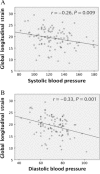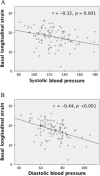Prognostic utility of blood pressure-adjusted global and basal systolic longitudinal strain
- PMID: 27249810
- PMCID: PMC5323871
- DOI: 10.1530/ERP-15-0037
Prognostic utility of blood pressure-adjusted global and basal systolic longitudinal strain
Abstract
Assessment of global longitudinal systolic strain (GLS) and longitudinal systolic strain of the basal segments (BLS) has shown prognostic value in cardiac disorders. However, strain is reduced with increased afterload. We assessed the prognostic value of GLS and BLS adjusted for afterload. GLS and BLS were determined in 272 subjects with normal ejection fraction and no known coronary disease, or significant valve disease. Systolic blood pressure (SP) and diastolic blood pressure (DP) obtained at the time of echocardiography were used to adjust GLS and BLS as follows: strain×SP (mmHg)/120 mmHg and strain×DP (mmHg)/80 mmHg. Patients were followed for cardiac events and mortality. The mean age was 53±15 years and 53% had hypertension. There were 19 cardiac events and 70 deaths over a mean follow-up of 26±14 months. Cox analysis showed that left ventricular mass index (P=0.001), BLS (P<0.001), and DP-adjusted BLS (P<0.001) were independent predictors of cardiac events. DP-adjusted BLS added incremental value (P<0.001) to the other two predictors and had an area under the curve of 0.838 for events. DP (P=0.001), age (P=0.001), ACE inhibitor use (P=0.017), and SP-adjusted BLS (P=0.012) were independent predictors of mortality. SP-adjusted BLS added incremental value (P=0.014) to the other independent predictors. In conclusion, DP-adjusted BLS and SP-adjusted BLS were independent predictors of cardiac events and mortality, respectively. Blood pressure-adjusted strain added incremental prognostic value to other predictors of outcome.
Keywords: 2D speckle-tracking echocardiography; afterload; basal systolic longitudinal strain; blood pressure; global systolic longitudinal strain.
© 2016 The authors.
Figures






References
-
- Nagata Y, Takeuchi M, Wu VC, Izumo M, Suzuki K, Sato K, Seo Y, Akashi YJ, Aonuma K, Otsuji Y. 2015. Prognostic value of LV deformation parameters using 2D and 3D speckle-tracking echocardiography in asymptomatic patients with severe aortic stenosis and preserved LV ejection fraction. JACC: Cardiovascular Imaging 8 235–245. (10.1016/j.jcmg.2014.12.009) - DOI - PubMed
-
- Buss SJ, Emami M, Mereles D, Korosoglou G, Kristen AV, Voss A, Schellberg D, Zugck C, Galuschky C, Giannitsis E, et al. 2012. Longitudinal left ventricular function for prediction of survival in systemic light-chain amyloidosis: incremental value compared with clinical and biochemical markers. Journal of the American College of Cardiology 60 1067–1076. (10.1016/j.jacc.2012.04.043) - DOI - PubMed
-
- Thavendiranathan P, Poulin F, Lim KD, Plana JC, Woo A, Marwick TH. 2014. Use of myocardial strain imaging by echocardiography for the early detection of cardiotoxicity in patients during and after cancer chemotherapy: a systematic review. Journal of the American College of Cardiology 63 2751–2768. (10.1016/j.jacc.2014.01.073) - DOI - PubMed
-
- Sitges M, Pham PN, Tran da T, Delgado V, Bertini M, Nucifora G, Vidaic J, Allman C, Holman ER, et al. 2009. Incremental value of 2-dimensional speckle tracking strain imaging to wall motion analysis for detection of coronary artery disease in patients undergoing dobutamine stress echocardiography. American Heart Journal 158 836–844. (10.1016/j.ahj.2009.09.010) - DOI - PubMed
LinkOut - more resources
Full Text Sources
Other Literature Sources
Miscellaneous

